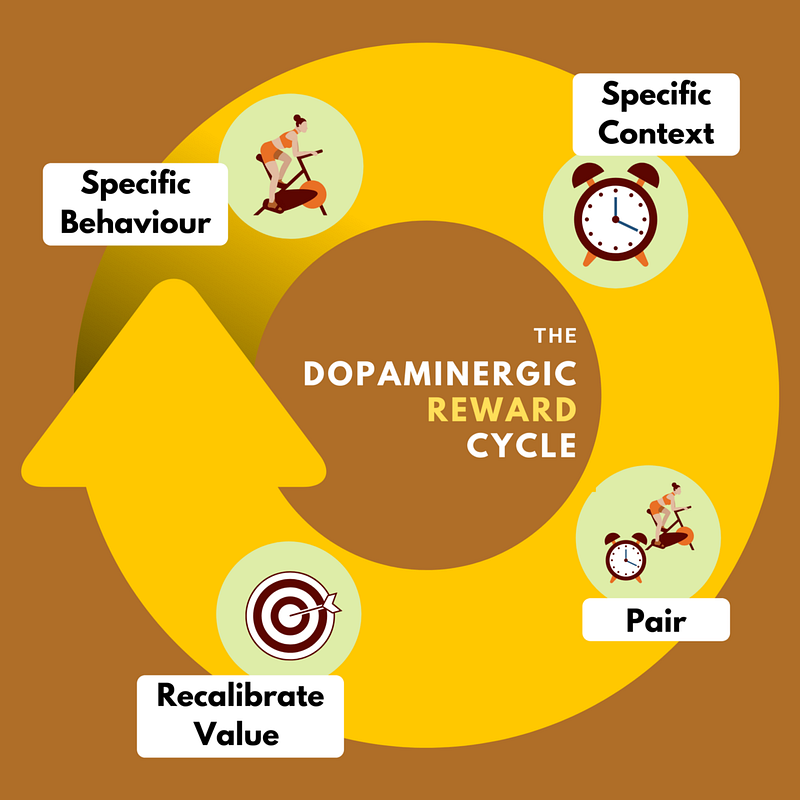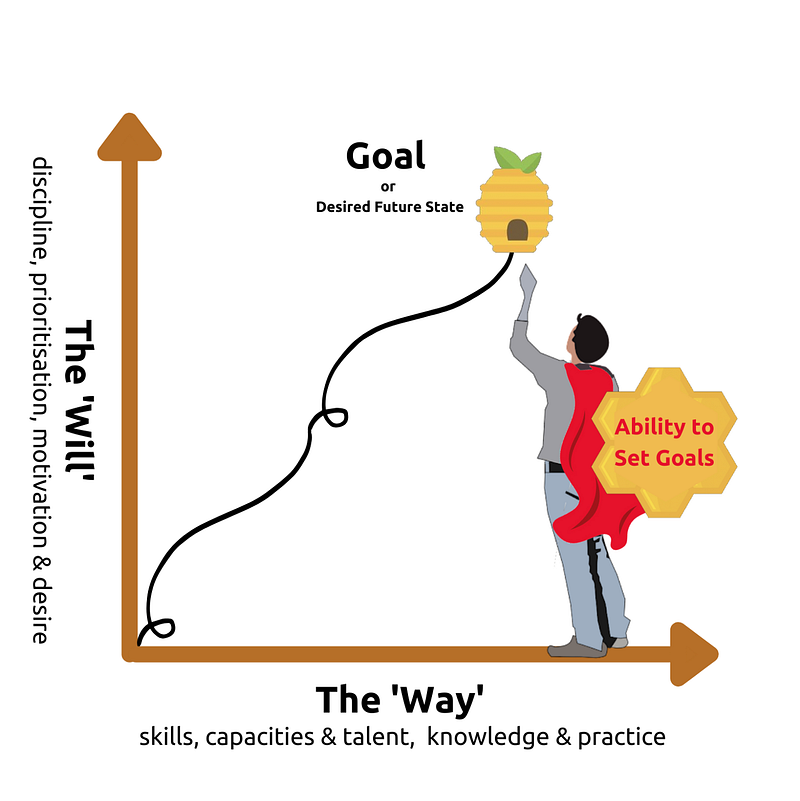Goals Are Built Into Life

Goals Are Built Into Life
Learn to hack the science of goal-setting
It is no secret that the ability to set goals is a critical skill — it is also a skill that is built right into our basic biology, and is one of the things that separates living beings — like us — from inanimate objects like rocks, clouds, and bodies of water.
“We observe a ‘goal-directed,’ ‘purposive,’ and ‘directive’ aspect in all organic activity. At every level of their functioning, organisms carry out tasks, satisfy needs, and pursue their own interests.”— E.S. Russel, Scottish biologist, and philosopher of biology
Some understanding of the science behind these phenomena can help us become more productive, happy, and self-aware — this article will attempt to unpack some of this science —as well as highlight how to hack it.
The Dopaminergic Reward Cycle
What is it?
Dopamine is so important to the fabric of our lives that if we didn’t have any, we wouldn’t even be able to move.
‘Directiveness’ or goal-driven behavior is evident in our biological makeup in the form of various neurotransmitters — notably, dopamine.

Dopamine — the achievement hormone — is a chemical that serves an important function in your body’s reward system. Higher levels of this chemical mean you will feel more alert, creative, focused — and will be able to remember information for longer periods of time.
When a particular behavior is exercised in a given context — it is rewarded, that specific behavior is then paired and tagged with a reward value (Rescorla & Wagner, 1972).
This value is continually ‘calibrated’ each time the pair are performed together and can be thought of as the amount of reward that an organism expects to receive for a given action — largely based on past learning.
This process of reinforcement learning is why behaviors that are rewarded are likely to be repeated in the future, as well as why this biological system is so implicated in addictive behavior.
This would explain why the technology-driven modern world of today has us fighting to retain enough of this finite chemical for ourselves and our own true desires. Netflix, video games, and social media all compete aggressively for their share of our Dopamine reservoirs — and it’s up to us not to let them have it all!
How to hack it
- Build and maintain a high — and stable — dopamine baseline. You can do this by avoiding huge spikes that don’t need to be ‘worked for’ (caused by things like social media, porn, and drugs); these spikes will cause crashes that leave you feeling more unproductive than ever.
- Break down your goals into manageable and achievable ‘chunks’. This creates a sequence of smaller ‘finish lines’ for frequent (but not excessive) dopamine release; also — don’t forget to celebrate the small wins!
- Chase your goals, not trophies. A Stanford study saw researchers take kids who enjoyed drawing, and give them rewards after finishing drawings; after a few weeks, they stopped giving the rewards. Attaching rewards to drawing — something the kids already enjoyed — took the pleasure out of the activity. This is contrary to common self-help advice, and also explains how people with a purposeful ‘why’ are often more driven than those without one. If you want to neutralize this dopamine volatility, randomize your rewards (Kernan, 2021).
- Be secretive about your goals. When we publicize our goal intentions, we actually get a dopamine hit somewhat due to others’ admiration for us for attempting such goals—we get a premature sense of ‘completeness’, and this will actually decrease the chance of actually achieving them.
- Take a cold shower. Cold water will give you a large (and natural) hit of dopamine — and it doesn’t come with a crash!
Executive Function
What is it?
Executive function is the name for the collection of skills that help you get things done (WebMD, 2021); controlled by the frontal lobe, these skills include attention, working memory, planning, and self-control.
A great deal of study has focused on this skill-set, particularly in Neuroscience — which focuses on the neural systems and circuits that implement executive function (Fox et al., 2005).
Interestingly, if we model behavior change into two dimensions, one motivational (the will) and the other cognitive (the way), executive function is very much part of the neuroscience behind ‘the way’.

Executive function has three characteristic features: it is effortful, operates consciously, and is engaged in service of novel goals as opposed to rote or known ones (e.g., Miyake & Friedman, 2012).
How to hack it
- Take short, frequent breaks. You may have noticed that your self-control and willpower may wane after doing the same task for an extended period of time — studies have shown that taking breaks or ‘brief diversions’ can dramatically improve one’s ability to focus on tasks for prolonged periods.
- Use the Pomodoro technique (PT). The PT is a time management tool that involves working for short bursts (usually 25 minutes each) separated by 5 minute breaks, it has shown to improve productivity and I have noticed this in my own life — it instills a sense of urgency as well as builds in the breaks you need to maintain focus for extended periods of time.
- Focus on training a specific ‘executive function task’. Whilst the research is fairly clear that executive function is more fixed than malleable by intervention, it is also true that people can improve on specific executive function tasks with practice (though it is not clear if and how this generalizes to other executive function tasks.)
“Operations of thought are like cavalry charges in a battle — they are strictly limited in number, they require fresh horses, and must only be made at decisive moments.” — Alfred North Whitehead, Mathematician & Philosopher
Neuroplasticity
What is it?
The ability of your brain to adapt and ‘rewire’ itself is known as neuroplasticity.
Doing things such as learning a new language, practicing a skill, and going through psychological stress all result in neuroplasticity through which your brain’s neurons and neural networks reorganize themselves and grow new connections.

When you set a goal that you care about and call back to mind frequently, a complex interplay between parts of your brain helps ensure that it is given priority in the competition for access to your selective attention (Compton, 2003).
Through neuroplasticity, goal-setting can literally rewire your brain so that you perceive and behave in ways that help you achieve the goals that are most important to you.
This has been seen in studies conducted on multiple sclerosis patients and stroke patients — where continual practice in pursuit of defined goals resulted in their brains healing faster.
It was once thought that neuroplasticity was manifest only in children — but further research into the 20th century revealed that many aspects of the brain remain malleable (‘plastic’) through adulthood — a child’s developing brain does still, however, exhibit higher degrees of neuroplasticity.
How to hack it
- Set SMART but ambitious goals, and fixate on them. If you are clear about what you want, and why you want it, your brain will rewire itself to help you get it. This is no mystical* ‘Law of Attraction’ but a biological reality.
- Seek out novel experiences. Whether this is moving to a new city or traveling to a foreign place, learning an instrument, or reading a book from a domain you know nothing about — all will create new neural pathways in your brain.
- Believe that you can, continually. Talent is real, but it is over-hyped. In his book ‘Outliers’, Malcolm Gladwell makes the case that achieving true expertise in any skill is simply a matter of practicing. Be persistent in pursuit of your goals.
- Keep your brain healthy. The importance of enough sleep, frequent exercise and a healthy diet cannot be overstated — also, taking a needed break or being out in nature can do wonders.
“Our beliefs control our bodies, our minds, and thus our lives.” — Bruce H. Lipton, The Biology of Belief
*I am not trying to be critical of the Law of Attraction here — who knows what may be going on ‘behind the veil’, in the metaphysical realm.
Of course, all of these hacks are best done after you’ve got the basics right—the importance of enough sleep, frequent exercise, and a healthy diet cannot be overstated.
Graphics have been created by me on Canva unless otherwise stated. Thanks for reading, and hope it was somewhat useful!
References
- Byrne, R. (n.d.). The Practical Ed Tech Handbook. [online] Available at: https://practicaledtech.com/wp-content/uploads/2021/08/Practical-Ed-Tech-Handbook-2021-22-School-Year-4.pdf [Accessed 17 Dec. 2021].
- degrees.snu.edu. (n.d.). The Importance of Goal Setting for Adult Students. [online] Available at: https://degrees.snu.edu/blog/the-importance-of-goal-setting-for-adult-students.
- Productivity (2012). How To Quit Your Day Job And Travel The World. [online] Mark Manson. Available at: https://markmanson.net/how-to-quit-your-job-and-travel-the-world#.h4omlt:CApF [Accessed 17 Dec. 2021].
- Wax, D. (2008). The Science of Setting Goals (And How It Affects Your Brain). [online] Lifehack. Available at: https://www.lifehack.org/articles/featured/the-science-of-setting-goals.html.
- Mayo Clinic (2020). Parkinson’s disease — symptoms and causes. [online] Mayo Clinic. Available at: https://www.mayoclinic.org/diseases-conditions/parkinsons-disease/symptoms-causes/syc-20376055.
- Berkman, E.T. (2018). The neuroscience of goals and behavior change. Consulting Psychology Journal: Practice and Research, 70(1), pp.28–44.
- Rescorla RA, Wagner AR. A theory of Pavlovian conditioning: Variations in the effectiveness of reinforcement and nonreinforcement. Classical Conditioning II Current Research and Theory. 1972;2:64–99. [Google Scholar]
- Rangel, A. and Hare, T. (2010). Neural computations associated with goal-directed choice. Current Opinion in Neurobiology, [online] 20(2), pp.262–270. Available at: https://pubmed.ncbi.nlm.nih.gov/20338744/.
- Russel, E. (1945). The Nature Institute. (n.d.). Goal Directed Activity in Life. [online] Available at: https://www.natureinstitute.org/article/e-s-russell/goal-directed-activity-in-life.
- Upenn.edu. (2019). Stairway to Recovery: Differences in the Pursuit of Pleasure. [online] Available at: http://www.uphs.upenn.edu/addiction/berman/neuro/dopamine.html.
- Mooventhan, A. and Nivethitha, L. (2014). Scientific evidence-based effects of hydrotherapy on various systems of the body. North American Journal of Medical Sciences, 6(5), p.199.
- www.psychologytoday.com. (n.d.). Why Sharing Your Goals Makes Them Less Achievable | Psychology Today South Africa. [online] Available at: https://www.psychologytoday.com/za/blog/neuroscience-in-everyday-life/201801/why-sharing-your-goals-makes-them-less-achievable [Accessed 17 Dec. 2021].
- ScienceDaily. (2011). Brief diversions vastly improve focus, researchers find. [online] Available at: https://www.sciencedaily.com/releases/2011/02/110208131529.htm.
- Usman, S. (2020). Using the Pomodoro Technique ® to help undergraduate students better manage technology-based multitasking during independent study: A design-based research investigation. [online] Available at: https://eprints.lancs.ac.uk/id/eprint/153513/1/2020usmanphd.pdf.
- Rugnetta, M. (2018). neuroplasticity | Different Types, Facts, & Research. In: Encyclopædia Britannica. [online] Available at: https://www.britannica.com/science/neuroplasticity.
- Compton, R.J. (2003). The Interface Between Emotion and Attention: A Review of Evidence from Psychology and Neuroscience. Behavioral and Cognitive Neuroscience Reviews, 2(2), pp.115–129.
- www.proquest.com. (n.d.). The use of individualized goal setting to facilitate behavior change in women with multiple sclerosis — ProQuest. [online] Available at: https://www.proquest.com/openview/e77ae438bf007ebeaf5890efccd79298/1?pq-origsite=gscholar&cbl=48278 [Accessed 17 Dec. 2021].
- John Hopkins Medicine (2019). Anatomy of the Brain. [online] Johns Hopkins Medicine. Available at: https://www.hopkinsmedicine.org/health/conditions-and-diseases/anatomy-of-the-brain.
- Lipton, B.H. (2016). The biology of belief : unleashing the power of consciousness, matter & miracles. Carlsbad, California: Hay House, Inc.
- Rainbow Rehabilitation Centers. (2014). Examples of Neuroplasticity in Cognitive Domains — Rainbow Rehabilitation Centers. [online] Available at: https://www.rainbowrehab.com/examples-neuroplasticity-cognitive-domains/.
- Markham, Julie & Greenough, William. (2004). Experience-driven brain plasticity: Beyond the synapse. Neuron glia biology. 1. 351–63. 10.1017/s1740925x05000219.
- Gladwell, M. (2008). Outliers : the story of success. New York: Back Bay Books, Cop.